| lithaz.org: home & art/culture events organizations publications |
| 2/10/2011 |
Lithuanian Easter Eggs:Decorating Traditions and Methods |
Symbolism And MythsThe hatching of a live chicken from an apparently inanimate egg is a source of wonderment for us today, but it was even more so to the ancients. It came to symbolize creation, fertility, and life. The ancient Egyptians, more than three thousand years ago, recorded on their papyrus scrolls their belief that the egg was a gift from their most powerful deity, the sun. Ancient Assyrians, Greeks and Romans also ascribed devine origins to the life-giving egg. The epic Kalevala of the Finns even claims that the egg was central to the creation of the world. |
Decorated EggsThe oldest known decorated eggs, two colored goose eggs with decorative scratches, were found in a 4th century grave of a young girl near Worms, Germany. By the 12th century, decorated eggs are blessed in churches during Easter ceremonies and the tradition to decorate eggs at Easter are wide-spread in Saxony, Bohemia, Poland, Ukraine, Romania, and Hungary. By the 13th century egg decoration is also known in Lithuania: archeaological digs at the base of Gediminas Hill in Vilnius uncovered decorated artificial eggs made of stone, clay, and bone. In 1549, Martynas Mazvydas, the author of the first Lithuanian book - a catechism, mentions the tradition of giving decorated eggs as gifts, and it is believed that by this time the tradition of decorating eggs during Lent was wide-spread in all parts of Lithuania. |
Mystical Powers Of Decorated EggsPeople in the countryside, even in recent times, believed that decorations added to the already existing mystical powers of the egg. A decorated egg afforded its owner protection from life's disasters and brought luck and fortune. The head of the household would bury a decorated egg at the threshold of the front door to his home as a way of protecting his family and home. Decorated eggs were also buried in the stable to protect the animals, in the fields to assure a plentiful harvest, and in the orchard to make the trees fruitful. It is no wonder that decorated eggs were welcome gifts and prized possessions. |
Images Of Drcorated Eggs |
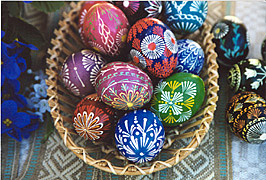
|
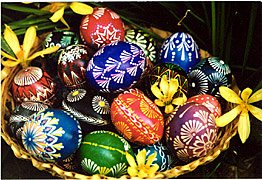
|
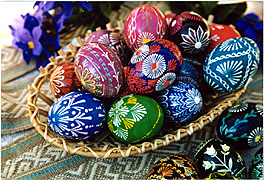
|
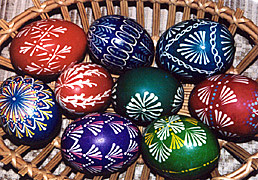
|
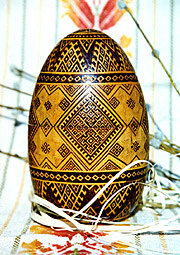
|
Choosing And Preparing The EggsThe eggs to be used for decoration should not be fresh. They should be at least 4 days old or, preferably, two weeks old. Medium sized, white and rounder eggs are best. To get the most uniform color during the dyeing process, the eggs must be thoroughly cleaned before being boiled. After boiling they must be carefully handled to avoid leaving oily fingerprints on the shell. |
Natural DyesTraditionally, dyes were derived from plants: yellow was obtained using dried birch leaves, yellow green - using birch leaves from young shoots, light brown - using onion peels, and grey - using oak bark. A variety of other light colors were obtained from dried flowers. Soaking and boiling a mixture of alder bark and rust produced a black dye. The colors were strengthened by adding vinegar or alum to the dyes. Table salt in the dye made colors less likely to rub off. |
Dying ProcessThe dye solution should be hot, but not boiling. The egg should be warm and dry before it goes into the dye bath. The greater the difference in temperature between the egg and the dye solution, the greater the chances for the shell to crack. Eggs can be kept warm by keeping them in warm water, but they must be carefully dried off prior to dyeing. The length of time in the dye solution determines the saturation of the resulting color. To give the surface of the dyed egg a shiny appearance, it was dried and then rubbed with unsalted pork fat right after it came out of the dye. After cooling, it was polished with a piece of woolen cloth. |
Scratch-Carve Method For Decorating Eggs
In Lithuania, two methods for decorating eggs were commonly used. One was based on producing designs on dyed eggs by scratching or carving the surface of the shell. This is a very simple method, requiring very simple tools - any sharp pointy tool can be employed. Short, straight, and white scratch lines are the basic elements of design for this method.
|
Wax-Resist Method For Decorating EggsCreating patterns with wax is the second method commonly used by Lithuanians for decorating eggs. Hot wax is applied with a pin, a small nail, a fishbone or a wooden splinter. The basic elements for creating decorative patterns with this method are dots and "tailed" dots. A dot is produced by dipping the tip of your tool into hot wax and setting it momentarily on the egg's surface. A "tailed" dot results when the tool is moved on the egg's surface.
After patterning the egg with wax, the egg is dyed in a solution that is cooler than the melting temperature of the wax. After dyeing, the wax is removed by heating the egg in an oven, rolling it on a hot towel, or any number of other ways. The removed wax reveals a white pattern. Multi-colored patterns can be obtained by repeated cycles of wax application and dyeing.
|
AcknowledgementThis page on Lithuanian Easter eggs came about through the efforts of Ona Adomaitis, Audrone Bartys, Gilanda and Casimir Matonis, Rima and Vytautas Reklaitis, and Aldona and Rimantas Vaitkus. |